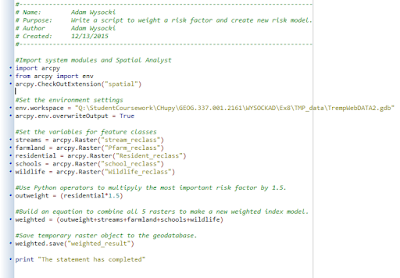The goal of this exercise was to gain familiarity downloading data from different sources. Initial data for the suitability and risk model for sand mining in Western Wisconsin was collected from a variety of federal government agencies and Trempealeau County. The data was imported into a working folder and then moved to a geodatabase. Understanding how to collect data from different sources is important to future success in the geospatial world.
Methods:
To create a frac sand minnig suitability and risk model, specific data was collected to map in ArcMap. The following lists what sources were used for the model, what data was collected, and how the data was obtained:
U.S. Department of Transportation
Railroad data for the United States was collected from the USDOT website. Information about railroads is useful because frac sand mines need to be close to railroads in order to ship their sand to consumers.
Accessing railroad data:
- Go to USDOT's data website: http://www.rita.dot.gov/bts/sites/rita.dot.gov.bts/files/publications/national_transportation_atlas_database/index.html
- Click on NTAD 2015,
- Click on "polyline"
- Download the "rail network" zip to temporary folder
- Unzip data to working folder
Once you have downloaded the Trempealeau County geodatabase (later in the lab), come back to these steps:
- Add the NTAD rail_lines shapefile from the USDOT data to ArcMap
- Add the railroads feature class from the Trempealeau County geodatabase
- Clip the NTAD rail_lines shapefile to the Trempealeau County boundary
- Import into the Trempealeau County Transportation feature dataset
USGS National Map: Landcover
Data for landcover of the United States was collected from the United States Geological Survey's National Map, which is a data resource that has data on elevation, landcover/landuse, hydrography, and more.
To access data on landcover:
- Go to the National Map website: http://nationalmap.gov/about.html
- Clici on "National Map Viewer and Download Platform"
- Click on "TNM Download Client"
- Select Trempealeau County as your area of interest using the Box/Point Polygon Tool
- Select "National Land Cover Database 2011" as your desired dataset.
- Download the zip to your temporary folder
- Unzip data to working folder
See Figure 1 for a summary of the data.
USGS National Map: Digital Elevation Model
The National Elevation Dataset (1/3 arc second) for Trempealeau County was downloaded from the USGS National Map using the same procedure for downloading landcover data, with a few extra steps:
- Select Trempealeau County as your area of interest again
- View products for Trempealeau County
- Select "National Elevation Dataset (1/3 arc second)"
- use the ArcGrid format
- Download data for both n44w092_13 and n45w092_13.
- Download zip folders to your temporary folder
- Unzip data to working folder
U.S. Department of Agriculture: Cropland
Information about cropland in Trempealeau County was downloaded because it is important to know if agriculture already exists in areas you plan to open a frac sand mine.
Accessing cropland data:
- Go to the USDA Geospatial Data Gateway: https://gdg.sc.egov.usda.gov/
- Click on the "Get Data" button
- Select "Wisconsin" and "Trempealeau County"
- Check "Cropland Data Layer by State" under "Land Cover"
- Send request for data
- Receive an email and download the data from the link
- Download zip folders to your temporary folder
- Unzip data to working folder
Trempealeau County Land Records:
The entire geodatabase for Trempealeau County was downloaded from the county's website: http://www.tremplocounty.com/landrecords/.
USDA NRCS Web Soil Survey:
Information about soil was collected because it can tell us important soil information, including soil type and drainage.
To access soil data:
- Go to http://websoilsurvey.sc.egov.usda.gov/App/HomePage.htm
- Set Trempealeau County as your AOI
- Go to the "Download Soils Data" tab and find Trempealeau County
- Download the zip file and unzip the file in Windows Explorer
- Use Microsoft Access to import the txt files your geodatabase
- Go to ArcCatalog and find the soildb_WI_2003.mdb
- Import the soilmu_a_wi121.shp into the Trempealeau County geodatabase you downloaded earlier
- name it soilmu_a_wi121_2
- Import the "component table" to the Trempealeau County geodatabase from the soildb_wi2003 geodatabase
- Create a relationship class between the "component table" and the soilsmu_a_wi121 feature class
- Add the soilsmu_a_wi121 feature class and "component" geodatabase to ArcMap
- Join the "component" table to the soilmu_a_wi121 feature class
See Figure 1 for a summary of the data.
Last Step for downloading the data:
- Combine the two DEM's for n44w092_13 and n45w092_13 using the "Mosaic to New Raster" tool in ArcMap.
- Save the output properly to avoid truncating the values
| Figure 1: Data was gathered from the above resources. See above instructions for specifics on downloading the data. |
Results:
Metadata:
Metadata is important because it can tell you how suitable data is for your project. Useful information included in metadata includes how the data was created, who created it, what is has been used for, how accurate it is, and more. The table below shows the metadata for all the data sources in this exercise (Figure 2). Metadata was compiled from metadata files/links for each separate piece of data.
I would say the metadata was well suited for the purposes of our studies. The data is mostly current, and is accurate at the county-level scale. Although the metadata was sometimes hard to locate, I was able to find most of the metadata. The only part of the metadata that was hard to locate was the attribute accuracy and minimum mapping unit.
 |
| Figure 2: Metadata for the collected data. |
Reference List:
Trempealeau County. (2015). Trempealeau County Land Records [geodatabase]. Retrieved from: http://www.tremplocounty.com/landrecords/
United States Department of Agriculture. (2015). NRCS Web Soil Survey [soil data set]. Retrieved from: http://websoilsurvey.sc.egov.usda.gov/App/HomePage.htm
United States Department of Agriculture. (2015). USDA Geospatial Data Gateway [cropland data set]. Retrieved from: https://gdg.sc.egov.usda.gov/
United States Department of Transportation. (2015). National Transportation Atlas Database [rail network data set]. Retrieved from: http://www.rita.dot.gov/bts/sites/rita.dot.gov.bts/files/publications/national_transportation_atlas_database/index.html
United States Geological Survey. (2015). The National Map [landcover and digital elevation model data sets]. Retrieved from: http://nationalmap.gov/about.html








